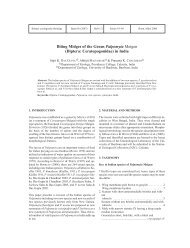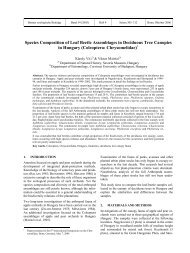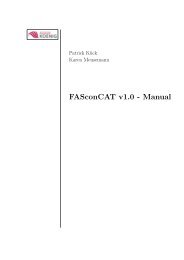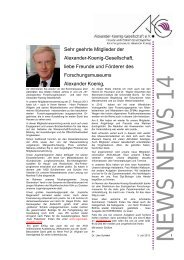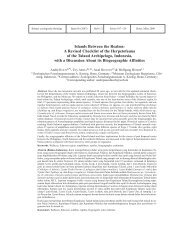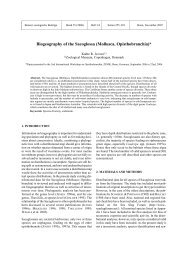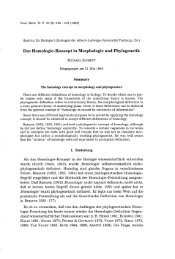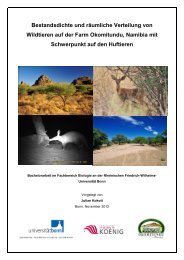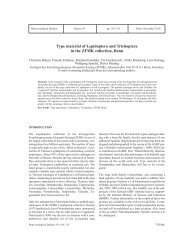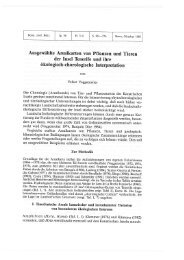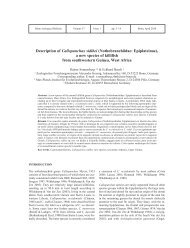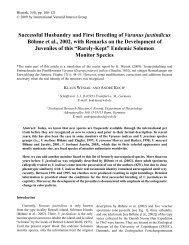cephalic shield
cephalic shield
cephalic shield
You also want an ePaper? Increase the reach of your titles
YUMPU automatically turns print PDFs into web optimized ePapers that Google loves.
Bonner zoologische Beiträge Band 55 (2006) Heft 3/4 Seiten 311–318 Bonn, November 2007<br />
The <strong>cephalic</strong> sensory organs of Acteon tornatilis<br />
(Linnaeus, 1758) (Gastropoda Opisthobranchia) –<br />
cellular innervation patterns as a tool for homologisation*<br />
Sid STAUBACH & Annette KLUSSMANN-KOLB 1)<br />
1) Institute for Ecology, Evolution and Diversity – Phylogeny and Systematics,<br />
J. W. Goethe-University, Frankfurt am Main, Germany<br />
*Paper presented to the 2nd International Workshop on Opisthobranchia, ZFMK, Bonn, Germany, September 20th to 22nd, 2006<br />
Abstract. Gastropoda are guided by several sensory organs in the head region, referred to as <strong>cephalic</strong> sensory organs<br />
(CSOs). This study investigates the CSO structure in the opisthobranch, Acteon tornatilis whereby the innervation patterns<br />
of these organs are described using macroscopic preparations and axonal tracing techniques.<br />
A bipartite <strong>cephalic</strong> <strong>shield</strong> and a lateral groove along the ventral side of the <strong>cephalic</strong> <strong>shield</strong> was found in A. tornatilis.<br />
Four cerebral nerves can be described innervating different CSOs: N1: lip, N2: anterior <strong>cephalic</strong> <strong>shield</strong> and lateral groove,<br />
N3 and Nclc: posterior <strong>cephalic</strong> <strong>shield</strong>. Cellular innervation patterns of the cerebral nerves show characteristic and constant<br />
cell clusters in the CNS for each nerve.<br />
We compare these innervation patterns of A. tornatilis with those described earlier for Haminoea hydatis (STAUBACH et<br />
al. in press). Previously established homologisation criteria are used in order to homologise cerebral nerves as well as<br />
the organs innervated by these nerves. Evolutionary implications of this homologisation are discussed.<br />
Keywords. Haminoea hydatis, Cephalaspidea, axonal tracing, homology, innervation patterns, lip organ, Hancock´s<br />
organ.<br />
1. INTRODUCTION<br />
Gastropoda are guided by several organs in the head region<br />
which are assumed to have primarily chemo- and<br />
mechanosensory functions (AUDESIRK 1979; DAVIS &<br />
MATERA 1982; BICKER et al.1982; EMERY 1992; CHASE<br />
2000; CROLL et al. 2003). In Opisthobranchia, these<br />
<strong>cephalic</strong> sensory organs (CSOs) present an assortment of<br />
forms including rhinophores, labial tentacles, oral veils,<br />
Hancock´s organs and <strong>cephalic</strong> <strong>shield</strong>s. Recent investigations<br />
of CSOs in Opisthobranchia have focussed primarily<br />
on functional aspects (CROLL 1983; BOUDKO et al.<br />
1999; CROLL et al. 2003) while homology of the different<br />
types of CSOs in different taxa has never been investigated<br />
in detail. We want to clarify their homology in separate<br />
evolutionary lineages so as to elucidate key questions<br />
regarding character evolution and phylogeny.<br />
Acteon tornatilis belongs to the subgroup Acteonoidea,<br />
formerly ascribed to the basal Cephalaspidea (ODHNER<br />
1939, BURN & THOMPSON 1998). However, recent investigations<br />
have either excluded the Acteonoidea from the<br />
Opisthobranchia (MIKKELSEN 1996) or proposed a sister<br />
group relationship of Acteonoidea and the highly derived<br />
Nudipleura (VONNEMANN et al. 2005) thus, rendering the<br />
phylogenetic position of Acteonoidea within Opisthobranchia<br />
unsettled. Acteonoidea are characterised by the<br />
presence of a prominent <strong>cephalic</strong> <strong>shield</strong>. This structure is<br />
also present in Cephalaspidea and has been considered to<br />
be an apomorphie of the Cephalaspidea (SC H M E K E L 1 9 8 5 ) .<br />
H o w e v e r, the structure of the <strong>cephalic</strong> <strong>shield</strong>s differs considerably<br />
in Cephalaspidea and Acteonoidea with the latter<br />
possessing two distinct hemispheres while the <strong>cephalic</strong><br />
<strong>shield</strong> in the Cephalaspidea possesses uniform structure.<br />
Therefore, common origin of both types of <strong>cephalic</strong><br />
<strong>shield</strong>s and thus homology is questionable. Further CSOs<br />
have been described in Acteonoidea and Cephalaspidea<br />
such as lip organ and Hancock´s organ (RUDMAN 1971A;<br />
RUDMAN 1971B; RUDMAN 1972a, b; RUDMAN 1972c;<br />
EDLINGER 1980).<br />
Since the presence of these organs in members of the<br />
genus Acteon has been disputed by different authors<br />
(EDLINGER 1980; SCHMEKEL 1985), absolute clarification<br />
is certainly necessary . The intention of this study is to describe<br />
the structure emphasizing the innervation of the<br />
CSOs in the acteonid A. tornatilis. Our descriptions focus<br />
on the cellular innervation patterns reconstructed for
312 Sid STAUBACH & Annette KLUSSMANN-KOLB: Cephalic sensory organ in Aceton<br />
the cerebral nerves using axonal tracing. In an earlier study<br />
(STAUBACH et al. in press) these cellular innervation patterns<br />
were shown to be more adequate in homologising<br />
cerebral nerves than ganglionic origins of nerves (HUBER<br />
1993). By comparising the innervation patterns in A. tor -<br />
n a t i l i s to previously published data on H. hydatis<br />
(STA U B A C H et al. in pre s s), we want to survey whether the<br />
preliminary characteristic cell clusters in the central nervous<br />
system (CNS) of both taxa can be identified by homologising<br />
cerebral nerves across taxa. Based on the homologisation<br />
of the nerves innervating the CSOs we want<br />
to clarify if A. tornatilis has homologous structures to the<br />
CSOs of Cephalaspideans. It is our intent interest that we<br />
shed light on the phylogenetic position and evolutionary<br />
history of Acteonoidea within the Opisthobranchia for future<br />
studies.<br />
2. MATERIALS AND METHODS<br />
2.1. Specimens<br />
A. tornatilis (Fig. 1A) were collected in the wild at St.<br />
Michel en Greve (Brittany, France). They were then stored<br />
alive at our lab in Frankfurt. Fourty specimens measuring<br />
a shell length between 15 and 20 mm were traced directly<br />
(5 to 15 days after collecting) and five were fixed<br />
for SEM.<br />
2.2. Tracing studies<br />
Animals were relaxed with an injection of 7 % magnesium<br />
chloride. The central nervous system consisting of<br />
the cerebral, pleural and pedal ganglia was removed and<br />
placed in a small Petri dish containing filtered artificial<br />
seawater (ASW; Tropic Marin, Rebie-Bielefeld; GER-<br />
MANY). We then followed the procedures from CROLL<br />
& BAKER (1990) for Ni 2+ -lysine (Ni-Lys) tracing of axons.<br />
Briefly, the nerves of the right cerebral ganglion were<br />
dissected free from the connective tissue. The nerves were<br />
cut and the distal tip was gently drawn into a glass micropipette<br />
using suction provided by an attached 2.5 ml<br />
syringe. Subsequently, the saline in the micropipette was<br />
replaced by a Ni-Lys solution (1.9g NiCl-6H 2 O, 3,5 g L-<br />
Lysine freebase in 20 ml double distilled H 2 O). The preparation<br />
was then incubated for 12–24 hours at 8º C to allow<br />
transport of the tracer. The micropipette was then removed<br />
and the ganglia were washed in ASW three times.<br />
The Ni-Lys was precipitated by the addition of five to ten<br />
drops of a saturated rubeanic acid solution in absolute Dimethylsulfoxide<br />
(DMSO). After 45 minutes the ganglia<br />
were transferred to 4 % paraformaldehyde (PFA) and fixed<br />
for 4–12 hours at 4º C. Thereafter the ganglia were dehydrated<br />
in an increasing ethanol series (70/80/90/99/99%<br />
10 minutes each), cleared in methylsalicylate and mounted<br />
on an objective slide dorsal side up in Entellan (VWR<br />
International) and covered with a cover slip. Ten replicates<br />
were prepared for each cerebral nerve of A. tornatilis.<br />
Samples with only a partial staining of the nerve were not<br />
used because of possible incomplete innervation patterns.<br />
Our criterion for a well-stained preparation was a dark blue<br />
stained nerve indicating intact axons ( FR E D M A N 1 9 8 7 ). T h e<br />
Ni-Lys tracings were analysed by light microscopy (Leica<br />
TCS 4D). Camera lucida drawings were digitalised following<br />
the method of CO L E M A N ( 2 0 0 3 ) adapted for Corel-<br />
DRAW 11. The somata in the innervation scemes occurs<br />
in all replicates. Somata only occurring in single samples<br />
are not considered part of the schematics. The axonal pathways<br />
are estimated over all replicates. Additionally, we<br />
tested for asymmetries making axonal tracings (n = 2 to<br />
3) for each cerebral nerve of the left cerebral ganglion.<br />
2.3. Scanning electron microscopy studies<br />
The specimens were relaxed by an injection of 7 % Mg-<br />
C l 2 in the foot. T h e r e a f t e r, the entire head region was dissected<br />
from the rest of the animal. The CSOs were fixed<br />
in 2,5 % glutaraldehyde, 1 % paraformaldehyde in 0,1M<br />
phosphate buffer (pH 7,2) at room temperature. For the<br />
SEM, the fixed CSOs were dehydrated through a graded<br />
acetone series followed by critical point drying (CPD 030,<br />
BAL-TEC). Finally, they were spattered with gold (Sputter-Coater,<br />
Agar Scientific) and examined with a Hitachi<br />
S4500 SEM. All photographs were taken using DISS (Digital<br />
Image Scanning System – Point Electronic) and subsequently<br />
adjusted for brightness and contrast with Corel<br />
PHOTO-PAINT 11.<br />
3. RESULTS<br />
3.1. Organisation and innervation of the <strong>cephalic</strong> sensory<br />
organs<br />
A. tornatilis possesses a prominent bipartite <strong>cephalic</strong> <strong>shield</strong><br />
(cs) in which each hemisphere of this <strong>shield</strong> is divided into<br />
an anterior and a posterior lobe (Figs. 1A and B). Eyes<br />
are embedded deeply within the tissue of the <strong>shield</strong>. A l o n g<br />
the lateral margin of the anterior lobe of the <strong>cephalic</strong> <strong>shield</strong><br />
a groove is present (Fig. 1B, 2A). Hidden under the cs and<br />
above the foot, the mouth opening is situated at the median<br />
frontal edge (Fig. 2B) surrounded by the lip (not visible<br />
in Figure 2B). We found four nerves innervating the<br />
CSOs (Fig.1B). The N1 (Nervus oralis) provides innervation<br />
to the lip and small median parts of the anterior<br />
<strong>cephalic</strong> <strong>shield</strong>. The bifurcated N2 (Nervus labialis/labiotentacularis)<br />
innervates the complete anterior <strong>cephalic</strong><br />
<strong>shield</strong> whereby the groove at the ventral anterior lobe of<br />
the <strong>cephalic</strong> <strong>shield</strong> is especially innervated. The small N3<br />
(Nervus tentacularis/rhinophoralis) innervates a little re-
Bonner zoologische Beiträge 55 (2006)<br />
313<br />
gion of the posterior <strong>cephalic</strong> <strong>shield</strong>. The Nclc (Nervus<br />
clypei capitis) innervates the largest hind part of the posterior<br />
<strong>cephalic</strong> <strong>shield</strong>. We could not detect a lip organ (Fig.<br />
2B), which according to ED L I N G E R (1980) should comprise<br />
two small lobes on the <strong>cephalic</strong> <strong>shield</strong> above the mouth.<br />
A Hancock´s organ described by EDLINGER (1980) for A.<br />
Tornatilis, here a folded structure separated from the<br />
<strong>cephalic</strong> <strong>shield</strong> was likewise not found in the present study.<br />
3.2. Tracing studies<br />
By conducting the axonal tracing studies we were able to<br />
reconstruct cellular innervation patterns for the four cerebral<br />
nerves of A. tornatilis. Ten replicate tracings were performed<br />
each for the N1 N2, N3 and Nclc using only the<br />
nerves of the right cerebral ganglion. The characteristic<br />
patterns of labelled somata for all nerves are shown in Figure<br />
3A-D, including the approximate pathways of the<br />
stained axons. The identified clusters were named with abbreviations<br />
signifying the ganglion in which they are located,<br />
the nerve filled and a number indicating the order<br />
of their description (for example, Cnlc3: Cerebral Nervus<br />
labialis cluster 3). Nerve cells are grouped in clusters on<br />
the basis of their close positioning in the ganglia and the<br />
tight fasciculation of their axons projecting into the filled<br />
nerve. Asymmetries for tracings of the left nerves could<br />
not be detected.<br />
For the N1 (n = 10) we identified six cerebral clusters<br />
(Cnoc1-6) and one pedal cluster (Pdnoc1) in each sample<br />
(Fig. 3A). The variation between the samples was restricted<br />
to very few somata in some clusters. The cerebral<br />
clusters were distributed over the whole cerebral ganglion.<br />
The pedal cluster Pdnoc1 was located on the anterior margin<br />
of the pedal ganglion above the pedal commissure. T h e<br />
innervation pattern of the N2 (n=10) consists of five cerebral<br />
clusters (Cnlc1-5) and three pedal clusters (Pdnlc1-<br />
3) (Fig. 3B). The cerebral clusters show distinct spatial<br />
separations and are easy to identify. The third traced cerebral<br />
nerve (n = 10) was the N3. Six cerebral (Cnrc1-6) and<br />
three pedal clusters (Pdnrc1-3) were identified (Fig. 3C).<br />
We found an additional single cluster (C c l n rc 1) and a single<br />
soma in the left cerebral ganglion (see arrows in Fig.<br />
3C). The contralateral cluster was located at the base of<br />
the N2 whereas the single soma was found at the root of<br />
the cerebral commissure. We observed slight intraspecific<br />
variability between the ten samples which amounted only<br />
to very few somata in some clusters. In the Nclc, the<br />
innervation (n = 10) pattern consisted of five cerebral clusters<br />
(Cncc1-5) and a single soma at the lateral margin of<br />
the cerebral ganglion above the pedal connective (Fig.<br />
3D). Additionally we found four pedal clusters (Pdncc1-<br />
4). The Nclc had the highest amount of pedal clusters in<br />
all investigated nerves. The number of pedal somata, however,<br />
was comparable to the number of pedal somata for<br />
the N2 innervation pattern (Fig 3B).<br />
Fig. 1. A: Photograph of Acteon tornatilis with the <strong>cephalic</strong> <strong>shield</strong> visible. B: Schematic illustration of the CNS, the four cerebral<br />
nerves (excluding the optical nerve) and the <strong>cephalic</strong> sensory organs of Haminoea hydatis and Acteon tornatilis. Only the right<br />
cerebral nerves are shown. N1 Nervus oralis, N2 Nervus labialis, N3 Nervus rhinophoralis, Nclc Nervus clypei capitis, ey eye, gr<br />
groove, al anterior lobe, pl posterior lobe, sh shell, cs <strong>cephalic</strong> <strong>shield</strong>, f foot.
314 Sid STAUBACH & Annette KLUSSMANN-KOLB: Cephalic sensory organ in Aceton<br />
Fig. 2. A. Lateral SEM photography of the groove at the ventral surface of the <strong>cephalic</strong> <strong>shield</strong> of Acteon tornatilis. cs <strong>cephalic</strong><br />
<strong>shield</strong>, gr groove. B. Frontal SEM photography of the mouth region of Acteon tornatilis. cs – <strong>cephalic</strong> <strong>shield</strong>, mo – mouth, f – foot.<br />
4. DISCUSSION<br />
The present study demonstrates the constancy of nervous<br />
structures in the opisthobranch mollusc. Throughout our<br />
investigation of several individuals of the acteonid, A c t e o n<br />
tornatilis we found uniform innervation patterns of the<br />
head region via four cerebral nerves, which can be attributed<br />
to characteristic neuronal cell clusters in the CNS.<br />
These cellular innervation patterns in A. tornatilis show<br />
an extremely high congruence with the cellular innervation<br />
patterns described for the four cerebral nerves of<br />
Haminoea hydatis (STAUBACH et al. in press).<br />
In the N1, the number of cerebral clusters as well as the<br />
position of these clusters to each other is the same in A.<br />
tornatilis and H. hydatis. However, we found some differences<br />
in the size and number of somata when comparing<br />
both species. A d d i t i o n a l l y, we could not detect a pleural,<br />
a parietal and a pedal cluster in A. tornatilis, which<br />
were described for H. hydatis. This may be due to the differences<br />
in the peripheral innervation area of the N1. In<br />
A. tornatilis it only provides for the lip and very small parts<br />
of the median <strong>cephalic</strong> <strong>shield</strong> whereas in H. hydatis, it innervates<br />
the lip and large parts of the anterior <strong>cephalic</strong><br />
<strong>shield</strong>. For the second nerve, the N2 (Nervus labialis), we<br />
nearly found no differences between the presence and distributions<br />
of the cell clusters for both species. The only<br />
ostentatious difference was the lack of a single pedal soma<br />
and its contra-lateral analogue in A. tornatilis. In the<br />
Nclc (Nervus clypei capitis), the difference between the<br />
two species was also reduced to the presence of a single<br />
cerebral soma in A. tornatilis. In contrast to the three<br />
nerves described above, we found a prominent difference<br />
in the structure of the N3 when comparing Acteon and<br />
Haminoea. On the other hand, in H. hydatis the N3 terminates<br />
in a rhinophoral ganglion. Such a ganglion is<br />
missing in A. tornatilis. Hence, we expected considerable<br />
differences in the cellular innervation patterns for the N3<br />
of these species. However, these differences were marg i n-<br />
al and only amounted to the lack of one single cell soma<br />
in the cerebral ganglion of A. tornatilis. This implies that<br />
basic innervation patterns of the N3 are probably the same<br />
in both species. Additional functions of the N3 processed<br />
in the rhinophoral ganglion can be proposed for H. hydatis.<br />
These functions are probably related to the Hancock´s organ,<br />
which is innervated by nerves originating in the<br />
rhinophoral ganglion (STA U B A C H et al. in pre s s). We were<br />
unable to locate such an organ in A. tornatilis in contrast<br />
to earlier descriptions (EDLINGER 1980).<br />
Upon comparing the innervation patterns presented here<br />
for A. tornatilis with those for H. hydatis (STAUBACH et<br />
al. in press) we find constant features of these patterns<br />
across species. This is congruent with other findings that<br />
neuronal structures in the central nervous system of molluscs<br />
and other invertebrates seem to be highly conserved<br />
(CROLL 1987; ARBAS 1991; HAYMAN-PAUL 1991; KUTSCH<br />
& BREIDBACH 1994; NEWCOMB et al. 2006). Hence, we<br />
postulate the N1 of A. tornatilis to be homologous to the<br />
N1 (Nervus oralis) described by HU B E R ( 1 9 9 3 ) for Cephalaspideans.<br />
Additionally, we postulate homologies of the<br />
N2 and the N3 of A. tornatilis to the N2 (Nervus labialis)<br />
and N3 (Nervus rhinophoralis) of Chepalaspideans. This<br />
is congruent to the assumption of HOFFMANN (1939) that<br />
the c3 (after VAYSSIÈRE 1880) of H. hydatis represents the<br />
Nervus labialis and the c4 represents the Nervus tentacularis,<br />
here a synonym for the Nervus rhinophoralis (HU-<br />
B E R 1 9 9 3 ). Our data cannot support ED L I N G E R’S ( 1 9 8 0 ) d e-<br />
scription of independent nerves for the lip organ (N1 after<br />
Edlinger 1980) and the anterior Hancock`s organ (N2<br />
after Edlinger 1980). The Nclc of A. tornatilis also seems<br />
to be homologous to the Nclc of Cephalaspideans (Huber
Bonner zoologische Beiträge 55 (2006)<br />
315<br />
Fig. 3. Schematic outline of cell clusters providing the N1 (A), N2 (B), N3 (C) and Nclc (D) of Acteon tornatilis. The size and<br />
position of the somata were digitalized from a camera lucida drawing, the distribution of the axons are averaged from all replicates.<br />
N1 Nervus oralis, N2 Nervus labialis, N3 Nervus rhinophoralis, Nclc Nervus clypei capitis, N. opt. Nervus opticus, CG cerebral<br />
ganglia, RhG rhinophoral ganglia, PlG pleural ganglia, PdG pedal ganglia.
316 Sid STAUBACH & Annette KLUSSMANN-KOLB: Cephalic sensory organ in Aceton<br />
1993). HO F F M A N N (1939) described the same nerve as the<br />
Nervus proboscidis. We define this nerve however, as<br />
Nervus clypei capitis according to HUBER (1993).<br />
Considering the homologisation of the cerebral nerves in<br />
light of their neurological origin, neuro-anatomics and<br />
nervous innervation patterns, we postulate hypotheses of<br />
homologies respective of the organs innervated by these<br />
nerves. Thus, we consider the lip of A. tornatilis to be homologous<br />
to the lip of Cephalaspideans (HUBER 1993)<br />
since both organs are innervated by the N1. The same<br />
holds true for the small median parts of the <strong>cephalic</strong> <strong>shield</strong><br />
in Acteon and the anterior <strong>cephalic</strong> <strong>shield</strong> of Haminoea.<br />
We could not find a lip organ in A. tornatilis as described<br />
by EDLINGER (1980), but we detected a groove at the ventral<br />
side of the anterior <strong>cephalic</strong> <strong>shield</strong>. This groove is innervated<br />
by the N2 as is the lip organ of Cephalaspideans<br />
(HUBER 1993). Therefore, we postulate this groove to be<br />
homologous to the lip organ. This hypothesis is also supported<br />
by data on immunoreactivity against several neurotransmitters.<br />
In the groove of A. tornatilis as well as in<br />
the lip organ of H. hydatis, characteristic sub-epidermal<br />
sensory neurons containing catecholamines could be found<br />
in high density indicating that both organs are involved<br />
in contact chemoreception (S. FALLER, Frankfurt, pers.<br />
comm. 2007).<br />
The N2 of Haminoea is divided into two branches which<br />
are described as two single nerves by EDLINGER (1980).<br />
The first or inner branch provides the lip organ as described<br />
earlier. The second, outer branch is related to the<br />
anterior Hancock´s organ ( ED L I N G E R 1980; HU B E R 1 9 9 3 ).<br />
In Acteon we also found two branches of the N2: the inner<br />
one providing the largest part of the groove whereas<br />
the outer branch is restricted to a small region between<br />
the anterior and posterior lobe of the <strong>cephalic</strong> <strong>shield</strong>.<br />
Therefore, this latter region may be homologous to the anterior<br />
Hancock´s organ of H. hydatis and not to the posterior<br />
Hancock´s organ as described by EDLINGER (1980).<br />
The N3 of A. tornatilis provides a large part of the posterior<br />
<strong>cephalic</strong> <strong>shield</strong> but no identifiable posterior Hancock´s<br />
organ. Additional immunohistochemical and ultrastructural<br />
investigations could also not detect a posterior<br />
Hancock´s organ in A. tornatilis (S. FALLER, Frankfurt,<br />
pers. comm. 2007; GÖBBELER & KLUSSMANN-KOLB in<br />
p re s s). The posterior parts of the <strong>cephalic</strong> <strong>shield</strong>s in A c t e o n<br />
and Haminoea are probably equally homologous as both<br />
where innervated by the Nclc.<br />
The lack of a posterior Hancock´s organ in A. tornatilis<br />
might be due to three different reasons: 1. the ancestor of<br />
A. tornatilis never had a posterior Hancock´s organ; 2. the<br />
posterior <strong>cephalic</strong> <strong>shield</strong> of A. tornatilis may be a homologous<br />
structure to the posterior Hancock´s organ of H. hy -<br />
datis; and 3. the posterior Hancock´s organ has secondarily<br />
been reduced in A. tornatilis.<br />
The first hypothesis is rather implausible since we found<br />
a distinct N3 with conserved cellular innervation patterns<br />
in the central nervous system. If the ancestor of A. tornatilis<br />
never had a posterior Hancock´s organ, this nerve<br />
and associated neural structures should be lacking. Moreover,<br />
a Hancock´s organ has been described for other<br />
Acteonoidea (RU D M A N 1 9 7 1a, b; RU D M A N 1972a, b; RU D-<br />
MAN 1972c). If we consider the second explanation for<br />
lack of a posterior Hancock´s organ in A. tornatilis, we<br />
imply that the posterior <strong>cephalic</strong> <strong>shield</strong> in this species, innervated<br />
by the N3, presents a sensory organ as the Hancock´s<br />
organ in Cephalaspidea. However, immunohistochemical<br />
and ultrastructural investigations of the respective<br />
epithelia in A. tornatilis do not indicate a sensory function<br />
at all (S. FALLER, Frankfurt, pers. comm. 2007;<br />
GÖBBELER & KLUSSMANN-KOLB in press). We reject this<br />
hypothesis of homology of the posterior <strong>cephalic</strong> <strong>shield</strong><br />
in A. tornatilis and posterior Hancock´s organ in H. hy -<br />
d a t i s since we found no evidence for a function of the posterior<br />
<strong>cephalic</strong> <strong>shield</strong> as an olfactory sensory organ. Moreo<br />
v e r, the posterior <strong>cephalic</strong> <strong>shield</strong> is mostly innervated by<br />
the Nclc and not by the N3. The third hypothesis regarding<br />
the reduction of a Hancock´s organ seems to be the<br />
most plausible when the habitat and the food sources of<br />
A. tornatilis in comparison to H. hydatis are considered.<br />
The posterior Hancock´s organ is believed to be an olfactory<br />
sensory organ (AU D E S I R K 1979; EM E RY 1 9 9 2). H. hy -<br />
datis feeds on green algae which occur in patches in open<br />
water whereas A. tornatilis is a predator of soft invertebrates<br />
living up to ten centimeters in solid sand (FRETTER<br />
1939; YONOW 1989; own investigations). In such an environment,<br />
an olfactory sensory organ is not plausible<br />
since olfaction or distance chemoreception is generally associated<br />
with water currents, which are not substantial in<br />
a sandy substrate habitat. Here, a contact chemoreceptor,<br />
which is located near the edge of the <strong>cephalic</strong> <strong>shield</strong> is<br />
more plausible. This we witnessed in Acteon tornatilis v i a<br />
its display of a potentially chemoreceptive groove along<br />
the lateral margin of the anterior <strong>cephalic</strong> <strong>shield</strong>.<br />
This assumption of secondary reduction of the Hancock´s<br />
o rgan in the endobenthic A. tornatilis is also supported by<br />
the fact that a Hancock´s organ has been described for other<br />
epibenthic Acteonoidea (e. g. Bullina, Micromelo, Hy -<br />
datina) (RUDMAN 1971a, b; RUDMAN 1972a, b; RUDMAN<br />
1972a,b,c).<br />
Despite all discussion, homology of the described Hancock´s<br />
organs to those in Cephalaspidea cannot undoubtedly<br />
be proposed at this stage, particularly since data on<br />
innervation patterns in these acteonids are lacking to date.<br />
M o r e o v e r, current phylogenetic hypotheses (GR A N D E et al.
Bonner zoologische Beiträge 55 (2006)<br />
317<br />
2004; VO N N E M A N N et al. 2005) regarding Opisthobranchia<br />
propose an independent origin of Acteonoidea<br />
and Cephalaspidea, indicating convergent development of<br />
these sensory organs in both evolutionary lineages. Further<br />
studies will have us utilizing cellular innervation patterns<br />
for CSOs in order to compare several taxa while homologising<br />
the different types of CSOs in Opisthobranchia.<br />
This procedure will enable us to glean a better<br />
understanding of the evolution of these organs.<br />
Acknowledgements. Marc Hasenbank, Patrick Schultheiss and<br />
Christiane Weydig were constructive in locating the Acteon tor -<br />
natilis population at St. Michel en Greve. Thanks to Katrin<br />
Göbbeler and Simone Faller for their personal commitments.<br />
Roger Croll was always very helpful in discussing tracing patterns<br />
and CSOs. We are grateful to Angela Dinapoli, Adrienne<br />
Jochum and Alen Kristof for their comments on an earlier version<br />
of this manuscript.<br />
This study was supported by the German Science Foundation,<br />
KL 1303/3-1 and by the Verein der Freunde und Förderer der<br />
Johann-Wolfgang-Goethe Universität.<br />
Also thanks to an unknown referee who provided valuable comments<br />
on the manuscript.<br />
REFERENCES<br />
ARBAS, E. A. 1991. Evolution in nervous systems. Annual Review<br />
in Neuroscience 14: 9–38.<br />
AUDESIRK, T. E. 1979. Oral mechanoreceptors in Tritonia<br />
diomedea. Journal of Comparative Physiology 130: 71–78.<br />
BICKER, G., DAVIS, W. J. & MATERA, E. M. 1982. Chemoreception<br />
and mechanoreception in the gastropod mollusc Pleuro -<br />
branchea californica. Journal of Comparative Physiology 1 4 9:<br />
235–250.<br />
BO C K, W. J. 1989. The homology concept: its philosophical foundation<br />
and practical methodology. Zoologische Beiträge (Neue<br />
Folge) 32: 327–353.<br />
BOUDKO, D. Y., SWITZER-DUNLAP, M. & HADFIELD, M. G. 1999.<br />
Cellular and subcellular structure of anterior sensory pathways<br />
in Phestilla sibogae (Gastropda, Nudibranchia). Journal of<br />
Comparative Neurology 403: 39–52.<br />
BURN, R. & THOMPSON, T. 1998. Order Cephalaspidea. Pp<br />
943–959 in: BE E S L E Y, P. L., RO S S, G. J. B. & WE L L S, A . ( e d s . )<br />
Mollusca: The Southern Synthesis. Fauna of Australia. Vol.<br />
5, Part B. CSIRO Publishing, Melbourne.<br />
CHASE, R. 2000. Behavior and its neural control in gastropod<br />
molluscs. Oxford University Press, New York.<br />
COLEMAN, C. O. 2003. “Digital inking”: how to make perfect<br />
line drawings on computers.<br />
O rganisms, Diversity and Evolution 3: Electronical Supplement<br />
14: 1–14.<br />
CROLL, R. P. 1983. Gastropod chemoreception. Biological Reviews,<br />
Supplement 3, 58: 293–319.<br />
CROLL, R. P. 1987. Identified neurons and cellular homologies.<br />
Pp. 41–59 in: ALI, M.A. (ed.) Nervous Systems in Invertebrates.<br />
CR O L L, R. P. & BA K E R, M. 1990. Axonal regeneration and sprouting<br />
following injury to the cerebral-buccal connective in the<br />
snail Achatina fulica. The Journal of Comparative Neurology<br />
300: 273–286.<br />
CR O L L, R. P., BO U D K O, D. Y., PI R E S, A. & HA D F I E L D, M. G. 2003.<br />
Transmitter content of cells and fibers in the <strong>cephalic</strong> sensory<br />
organs of the gastropod mollusc Phestilla sibogae. Cell Ti s-<br />
sue Research 314: 437–448.<br />
DAV I S, W. J. & MAT E R A, E. M. 1982. Chemoreception in gastropod<br />
molluscs: electron microscopy of putative receptor cells.<br />
Journal of Neurobiology 13(1): 79–84.<br />
EDLINGER, K. 1980. Zur Phylogenie der chemischen Sinnesorgane<br />
einiger Cephalaspidea<br />
(Mollusca, Opisthobranchia). Zeitschrift für Zoologie, Systematik<br />
und Evolutionsforschung. 18: 241–256.<br />
EMERY, D. G. 1992. Fine structure of olfactory epithelia of gastropod<br />
molluscs. Microscopy Research and Technique 22:<br />
307–324.<br />
FREDMAN, S. M. 1987. Intracellular staining of neurons with<br />
nickel-lysine. Journal of Neuroscience Methods 2 0( 3 ) :<br />
181–194.<br />
FRETTER, V. 1939. The structure and function of the alimentary<br />
canal of some tectibranch molluscs, with a note on extraction.<br />
Transactions of the Royal Society of Edinborough 5 9:<br />
599–646.<br />
GÖBBELER, K. & KLUSSMAN-KOLB, A. 2007. A comparative ultrastructural<br />
investigation of the <strong>cephalic</strong> sensory organs in<br />
Opisthobranchia (Mollusca, Gastropoda). Tissue Cell, doi<br />
10.1016/j.tice.2007.07.02.<br />
GR A N D E, C., TE M P L A D O, J., CE RV E R A, J.L. & ZA R D O YA, R. 2004.<br />
Phylogenetic relationships among Opisthobranchia (Mollusca<br />
: Gastropoda) based on mitochondrial cox 1, trnV, and rrnL<br />
genes. Molecular Phylogenetics and Evolution 3 3( 2 ) :<br />
378–388.<br />
HANCOCK, A. 1852. Observations on the olfactory apparatus in<br />
the Bullidae. Annual Magazine of Natural History 2: 9.<br />
HAYMAN-PAUL, D. 1991. Pedigrees of neurobehavioral circuits:<br />
tracing the evolution of novel behaviours by comparing motor<br />
patterns, muscles and neurons in members of related taxa.<br />
Brain Behavioural Evolution 38: 226–239.<br />
HOFFMANN, H. 1939. Mollusca. I Opisthobranchia. Pp. 1–1248<br />
in: BR O N N S, H. G. (ed.) Klassen und Ordnungen des Ti e r r e i c h s<br />
III (1). Akademische-Verlagsgesellschaft, Leipzig.<br />
HUBER, G. 1993. On the cerebal nervous system of marine Heterobranchia<br />
(Gastropoda). Journal of Molluscan Studies 59:<br />
381–420.<br />
KUTSCH, W. & BREIDBACH, O. 1994. Homologous structures in<br />
the nervous systems of arthropoda. Advances in Insect Physiology<br />
24: 2–113.<br />
NEWCOMB, J.M., FICKBOHM, D.J. & KATZ, P.S. 2006. Comparative<br />
mapping of serotonin-immunoreactive neurons in the central<br />
nervous system of nudibranch molluscs. The Journal of<br />
Comparative Neurology 499: 485–505.<br />
MI K K E L S E N, P. M . 1996. The evolutionary relationships of<br />
Cephalaspidea s.l. (Gastropoda; Opisthobranchia): a phylogenetic<br />
analysis. Malacologia 37: 375–442.<br />
ODHNER, N.H. 1939. Opisthobranchiate Mollusca from the western<br />
and northern coasts of Norway. Kongelige Norske Videnskabernes<br />
Selskabs Skrifter NR No. 1: 1–93.<br />
RUDMAN, W.B. 1971a. The genus Bullina (Opisthobranchia) in<br />
New Zealand. Journal of the Malacological Society of Australia<br />
2(2): 195–203.<br />
RU D M A N, W. B. 1971b. The family Acteonidae (Opisthobranchia,<br />
Gastropoda) in New Zealand. Journal of the Malacological Society<br />
of Australia 2(2): 205–214.<br />
RUDMAN, W.B. 1972a. The anatomy of the opisthobranch genus<br />
H y d a t i n a and the functioning of the mantle cavity and alimentary<br />
canal. Zoological Journal of the Linnean Society 51:<br />
121–139.
318 Sid STAUBACH & Annette KLUSSMANN-KOLB: Cephalic sensory organ in Aceton<br />
RUDMAN, W.B. 1972b. Studies on the primitive opisthobranch<br />
genera Bullina Fèrussac and Micromelo Pilsbry. Zoological<br />
Journal of the Linnean Society 51: 105–119.<br />
RU D M A N, W. B. 1972c. A study of the anatomy of P u p a and M a x -<br />
a c t e o n (Acteonidae, Opisthobranchia), with an account of the<br />
breeding cycle of Pupa kirki. Journal of Natural History 6:<br />
603–619.<br />
SCHMEKEL, L. 1985. Aspects of evolution within the opisthobranchs.<br />
Pp. 221–267 in: TRUEMAN, E.R. & CLARKE, M.R.<br />
(eds.) The Mollusca. Vol. 1 0 Evolution. Academic Press, London.<br />
STAUBACH, S.E., SCHÜTZNER, P., CROLL, R.P. & KLUSSMANN-<br />
KOLB, A.Innervation patterns of the cerebral nerves in Hami -<br />
noea hydatis (Linnaeus 1758) (Gastropoda, Opisthobranchia)<br />
– A test for intraspecific variability. In press, Zoomorphology<br />
(2007).<br />
VAY S S I È R E, A . 1980. Recherches anatomiques sur les Mollusques<br />
de la famille des Bullidés Annales des Sciences Naturelle Zoologie<br />
6: 9.<br />
VO N N E M A N N, V., SC H R Ö D L, M., KL U S S M A N N- KO L B, A. &<br />
WÄGELE, H. 2005. Reconstruction of the phylogeny of the<br />
Opisthobranchia (Mollusca, Gastropoda) by means of 18S and<br />
28S rDNA sequences. Journal of Molluscan Studies 71:<br />
113–125.<br />
YO N O W, N. 1989. Feeding observations on Acteon tornatilis ( L i n-<br />
naeus) (Opisthobranchia, Acteonoidae). Journal of Molluscan<br />
Studies 55(1): 97–102.<br />
Author´s adresses: Sid STA U B A C H (corresponding author)<br />
and Annette KL U S S M A N N- KO L B, Institute for Ecology, Evolution<br />
and Diversity – Phylogeny and Systematics, J. W.<br />
G o e t h e - U n i v e r s i t y, Siesmayerstraße 70, 60054, Frankfurt<br />
am Main, Germany. E-mail: Staubach@bio.unifrankfurt.de;<br />
Klussmann-Kolb@bio.uni-frankfurt.de.




